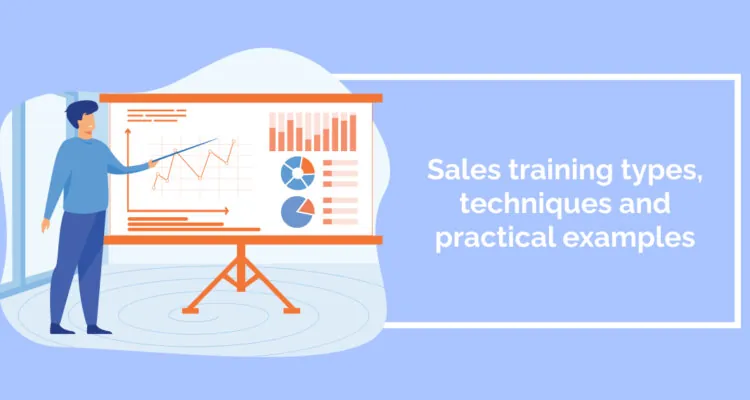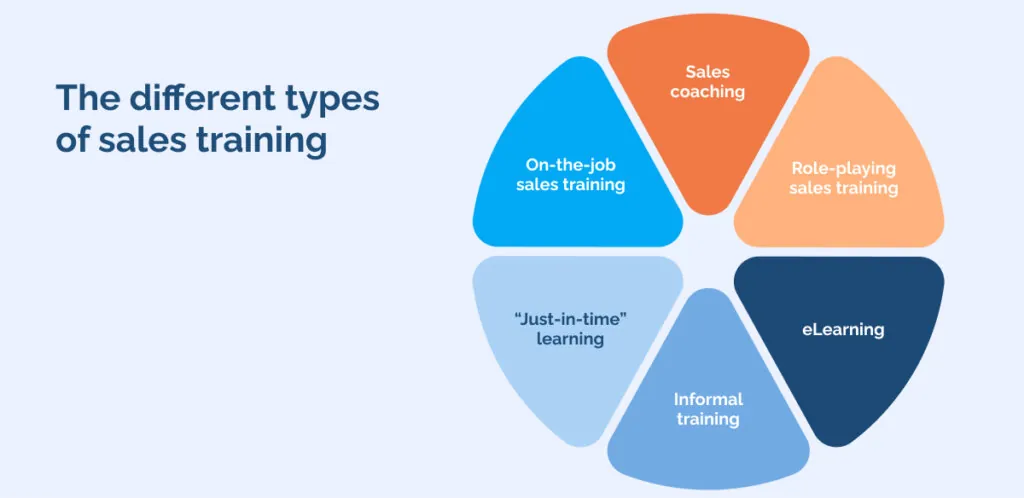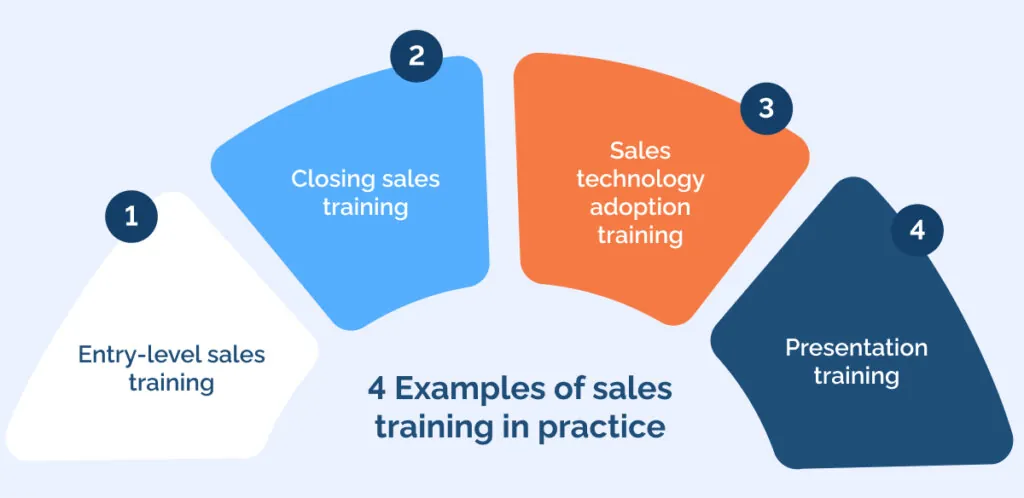
In a world where endless information is available at the end of our fingertips, sales professionals continue to have an important role. Whether in B2B or B2C operations, are a vital point of contact with consumers, “sensemaking” in a complex landscape of products and services (as Gartner analysts put it).
It’s no wonder, then, that sales training is even more important than ever. Training helps you to improve every part of your sales ecosystem. Whether your sales staff need complete overhaul, or just a bit of extra help, training can unlock the capabilities you need to succeed.
This article will explain the building blocks of an organizational training strategy for sales teams. It will:
- Define the meaning of sales training;
- Introduce you briefly to some of the major methods of delivery sales training;
- Go into some more detail about the specific cases in which sales training can be useful.
Some folks are natural salespeople. But even the best of them need training to get updated with product knowledge, technological implementation, and a changing market landscape.
What is sales training?
Sales training refers to any kind of intervention to improve the performance of sales employees. It may include sales-specific skills, such as product knowledge, sales techniques, presentation skills, or lead generation; but it could also involve generic workplace skills like time management, technology training, and communication.
Any sales professional will go through training programs throughout their career. Sales training can teach the fundamental skills of the job, provide upskilling in new and innovative methods, and deliver advanced techniques to experienced sales staff.
What are the different types of sales training?

Performing well in sales requires a combination of instinct, knowledge, and tactics. To disseminate those skills effectively, trainees need to have exposure to many types of learning interventions.
In this section, we’ve chosen six of the most important of employee training methods out of the many approaches that trainers have access to. They are:
- On-the-job sales training
- Sales coaching
- Role-playing sales training
- eLearning
- Informal training
- “Just-in-time” learning
Using these methods to implement sales training can give a great boost to your team.
On-the-job training
“On-the-job” training refers to a learning approach where individuals acquire practical skills, knowledge, and experience directly within the workplace while performing their regular job duties.
This method immerses sales professionals in real sales scenarios, enabling them to apply theoretical knowledge directly to their daily responsibilities. Some of the methods may include job rotation, shadowing colleagues, participating in live sales calls, and engaging in practical exercises. These tasks help trainees understand effective communication, customer relationship management, and sales techniques.
Sales coaching
Sales coaching involves the process of providing targeted guidance and support to sales professionals with the aim of enhancing their skills, performance, and overall effectiveness. A good coaching plan helps individual staff to identify areas for improvement, set goals, and receive personalized and actionable feedback.
Unlike generic training programs, coaching is specific to individual needs, allowing sales professionals to receive targeted guidance on their unique strengths and weaknesses. This individual attention helps in the practical application of theoretical sales training, ensuring that concepts learned in broader training sessions are effectively implemented in real-world scenarios
Simulation and role-play training
Role-play and simulation creating scenarios where sales professionals can simulate real-world sales interactions. Today, these methods have very wide applications in business training. From entry-level staff to senior executives, simulations help people to enact real-life problems with none of the dangerous consequences.
Sales is one of the most effective areas for simulation training. It allows sales professionals to practice and experiment with different sales strategies, objection-handling techniques, and communication approaches in a risk-free environment. It builds soft skills that contribute to more effective and adaptive sales practices.
eLearning for sales
Today, eLearning makes traditional training methods much easier to access: learners can get to tutorials, lectures, and online courses at their own pace. And more importantly, it unlocks a world of training that would be impossible to deliver otherwise. VR, quizzes, podcasts, and more, all create new learning experiences that make a huge impact.
Informal training
Informal training refers to the learning that occurs organically and spontaneously outside of formal, structured settings. It often takes place through day-to-day experiences, interactions, and self-directed activities, where individuals acquire knowledge and skills in an unstructured manner
This approach promotes adaptability and responsiveness to evolving market trends, customer needs, and industry dynamics. Embracing informal training methods in sales cultivates a culture of continuous learning, empowering sales teams to stay agile and consistently refine their skills in the ever-changing sales landscape.
“Just-in-time” training
“Just-in-time” learning is an approach where individuals gain knowledge at the exact moment they need it. This approach emphasizes providing information and training precisely when it is needed to address a specific task, challenge, or problem.
A 2023 report from Gartner explains how “just-in-time” training can be especially useful for sales training. They explain the following example:
“Consider a seller about to have a call with a new prospect. The seller hasn’t had time to prepare. But as the seller gets the calendar reminder for the call, they also get a pop-up with the top three open-ended discovery questions to use with a new prospect and a one-page profile of the prospect including size, industry, previous interactions and business challenges.”
In the fast-paced world of sales, there are many ways that “just-in-time learning can support employee upskilling. It is facilitated by new technology, particularly online platforms, mobile applications, and digital resources. Examples include short video tutorials, microlearning modules, quick reference guides, contextual help systems, and other easily accessible formats.
4 Examples of sales training in practice

Training sales staff can be used in many situations across a business. However, sales staff need highly specific interventions to make improvements in their work. In this section, we will introduce four of the most important examples of training in sales. They are:
- Entry-level sales training
- Closing sales training
- Sales technology adoption training
- Presentation training
If staff can improve in these areas, your overall business performance can make a dramatic improvement.
Entry-level sales training
In-house entry-level sales training will give participants a wide-ranging foundation in sales.
The priority of basic sales training is to introduce new salespeople to specific sales techniques, in prospecting, qualifying leads, pitching, and closing. To support that work, a lot of entry-level learning will be company-specific, such as product knowledge, technological skills, and customer understanding.
But a far wider range of general skills should accompany this such as communication, listening, time management, ethics, and resilience.
How to implement entry-level sales training
Entry-level training should use a wide variety of methods. Participants need to develop theoretical knowledge and practical skills to become successful sales people.
As a result, make sure your training programs include:
- Classroom or online learning
- Practical exercises
- Role-playing
- On-the-job training.
With exercises in all these areas, learners can build confidence in themselves at the start of their sales journey.
Who’s it for?
Basic sales training is usually aimed at new hires for the sales team.
Closing sales training
Closing sales is one of the tasks that bad salespeople get wrong consistently. Some aspects of closing should be studied in any basic sales education program. To improve their outcomes, employees may choose to undertake more specialized training in closing sales.
Closing sales training typically involves aspects such as effective closing techniques, understanding customer signals, handling objections confidently, creating a sense of urgency, and recognizing the opportune moment to ask for the sale.
How to implement it
To effectively implement sales closing training and enhance your team’s skills, consider incorporating the following methods:
- Role-playing scenarios: Engage your team in simulated sales situations to provide hands-on experience and build their confidence in closing deals. This allows them to practice various closing techniques in a controlled environment.
- Real-world case studies: Share and discuss actual success stories and challenges faced by your team or industry. Analyzing real-world scenarios helps sales professionals understand the practical application of closing strategies and adapt them to different situations.
- Practical exercises: Design interactive exercises that mimic the challenges encountered during the sales closing process. These exercises can include objection handling, negotiation simulations, and effective communication drills.
Who’s it for?
In some cases, entry-level sales teams might need help with closing. But it is best for intermediate-grade salespeople, with some experience in sales but looking to enhance their effectiveness in the critical closing stages of the sales process.
Sales technology adoption training
There are many software sales tools that are now essential for working in sales. And with the digital ecosystem changing every year, every salesperson will need to get to grips with new technologies.
Poor training can cause many problems for sales professionals. And even with tech-savvy staff, digital friction can have a major negative impact on sales performance. Effective training is one of the solutions to this problem.
How to implement it
Everyone wants to make technology intuitive and easy to use. But in reality, you need a multimodal approach to make technology truly usable.
So, think about the following steps when you’re implementing software for your sales team:
- Your sales tech training can include some elements of instructor-led training – especially when there are extensive changes that everyone needs to get familiar with. You can deliver these in-person or through virtual classrooms, allowing for real-time interaction, Q&A sessions, and immediate feedback.
- Once your systems are up and running, “Just in time” training can be effective. For example, on contextual help systems and digital adoption platforms can be some of the most effective ways to keep staff on top of new workflows.
- Finally, remember – training is only part of the solution. If you are implementing a large-scale software implementation, training will be very effective as part of a wider change management strategy.
Who’s it for?
Everyone in a sales team will use technology – so everyone needs to be up to date on the latest software rollouts. However, you should carefully tailor your software training programs.
Presentation training
Presentation skills are crucial in many aspects of sales for several reasons. A great presentation influences customers by conveying the value of a product effectively. I can capture attention, establish credibility, and build trust with the audience, essential elements in the sales process.
For complex products and services, presentations are the best opportunity to communicate complex information in a clear, interesting, and persuasive manner. Whether it’s a formal pitch, a product demonstration, or a sales proposal, honing presentation skills equips salespeople with the ability to deliver impactful messages.
Presentation training should include:
- Tailoring presentations to their needs
- Story-telling and organization
- Visual aids
- Mastering body language
- Vocal delivery
- Handling questions
Some people are natural with all these skills, but most people take many years to truly master everything.
How to implement it
Some of the key strategies for implementing presentation training include:
- Reviewing example presentations. Most people have prior conceptions about what makes a good and bad presentation – and looking at examples is the best way to understand those priorities. Online learning, lectures, job shadowing, and reflective journaling, can all help trainees see how to make their presentations better.
- Delivering mock presentations. This is a low-stakes way to put your skills into practice, receive feedback, and build confidence. Leaders and managers should try to create opportunities for mock presentations within their departments: it’s not always easy to find an audience.
- Use on-the-job training to deploy staff on presentation tasks. They can perform well in incrementally more challenging presentation tasks, receiving support until they are confident speakers.
- Coaching can be an excellent training method for more focused individual work. Through one-on-one coaching sessions, sales professionals can refine their delivery, address specific challenges, and receive targeted insights that enhance their presentation skills, fostering continuous improvement and confidence in engaging with potential customers.
Presentation training can take the form of an intensive and holistic program. But you can make major strides in your presentation skills even by casually focusing on just one element.
Who’s it for?
Presentation skills are valuable for anyone working in customer-facing roles. Even if they don’t give formal presentations every day, presentation training encourages best practice for many communications. Account executives, sales representatives, and business development managers can all especially benefit from presentation training.
How to make sales training effective

Sales teams perform a vital role, building the transactions that really make a difference to business success. Leaders that make training a top priority will get the best out of their teams, month to month and year to year.
This article has introduced some of the most important methods for training today, and the key moments in the work of a sales professional when they can be implemented. However, this is only part of the story.
In sales, there is a huge difference between good and bad training. As a useful McKinsey report explains, sales training programs do much better when they have clear learning journeys, continual investment, and ongoing monitoring systems.
WalkMe Team
WalkMe spearheaded the Digital Adoption Platform (DAP) for associations to use the maximum capacity of their advanced resources. Utilizing man-made consciousness, AI, and context-oriented direction, WalkMe adds a powerful UI layer to raise the computerized proficiency, everything being equal.



